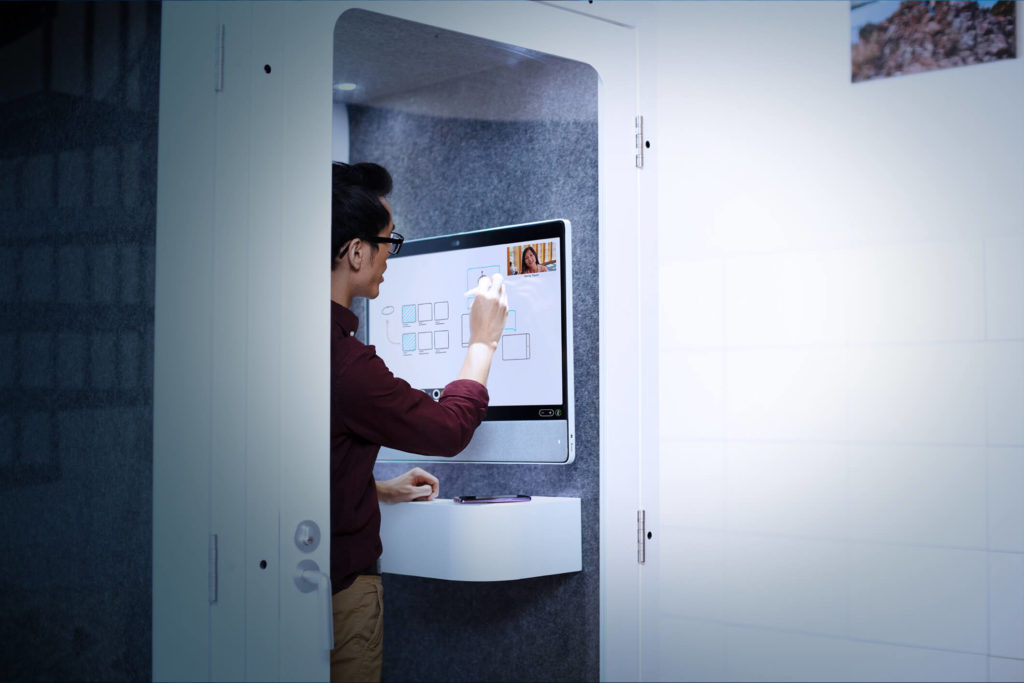CBTS recently put together a three-part webcast series centered on Microsoft Teams and competing collaboration tools. Part one of the webcast series, moderated by Channel Chief Rob Messmer, features CBTS Sr. Director of Solution Engineering Matt Douglass, Senior Solutions Architect Justin Rice, and Senior Sales Engineer Alex Broome. Part one is a comparison of major collaboration platforms and how they integrate with UCaaS.
The second part of the CBTS webcast series takes a technical deep dive into Cisco Webex Teams, Microsoft Teams Direct Route, and UCaaS. CBTS Director of Solution Design Chris Pope joins the panel to break down the little-known advantages of Cisco’s Webex Teams toolset and the new integrations with CBTS Cisco UCaaS offerings.
The third and final part of the webcast series features an expert panel including Cisco Cloud Calling Specialist Bryan Wilson, CBTS Director of Cloud Networking Jon Lloyd, and CBTS Senior Director of Solution Engineering Matt Douglass. Together, they break down what collaboration tools mean to the new work-from-home paradigms.
Bryan Wilson, please give an introduction and explain who you are and what you do for Cisco.
“I’m a Cloud and Hosted Calling Product Specialist at Cisco. I came into Cisco via the BroadSoft acquisition. I support partners like CBTS in navigating all the architecture offerings that we have at Cisco.” – Bryan Wilson, Cisco Cloud Calling Specialist
Matt, can you explain some of the differentiators between both platforms and why someone might look at Cisco Webex Teams vs. Microsoft Teams?
“Webex Teams for BroadWorks—which is really Webex Teams and Webex Meetings—I think is a game changer approach. Clients have all the things you’d expect in a comprehensive environment that goes along with our BroadWorks call control. So we’re trying to help customers understand they don’t necessarily need Microsoft Teams because really when we sell this new kind of UCaaS 2.0 clients can set aside Microsoft Teams.” – Matt Douglass, CBTS Sr. Director of Solution Engineering
Read more: How to train your organizations to use Microsoft Teams
We hear a lot of terms around Microsoft Teams, Cisco Webex Teams, Microsoft Direct Route, and UCaaS. All of these offerings are discussed together. How can we talk to customers in ways that bring them all into a common solution?
“I think that’s probably the biggest opportunity for us and for partners with customers today, because customers are still confused when they think about it. They think they get Microsoft Teams, it’s on their desk, and they can turn it into a telephone. But that’s not the case. One of the great opportunities for partners with vendors like ourselves with companies like CBTS, is that now we can come in and really do a consultative approach and understand again, what are their business problems, and we just get to be more glue to help understand and you teach them really, that okay, you think maybe you’re going to move all your voice components there? Well, that’s not going to happen, you’re going to have to have a mix and match of different pieces.” – Matt Douglass
With COVID changing the way we work to a new model of work-from-home, how does Cisco view this new world?
“If you look back maybe two years, the rate of video participation was only 30%. Most people would just be on audio during a web meeting. But since COVID, I’ve personally seen video participation well above 80% on every call I’m on. We’re going to start seeing pieces of plastic that were dedicated for calling be changed out for pieces of plastic dedicated for video.” – Bryan Wilson
With work-from-home users, how does SD-WAN play into that world?
“I have an SD-WAN device that sits here in my network. It can broadcast a wireless SSID, that SSID can have radius authentication back to my corporation so now I’m tied in. I can create a work specific segment to it, and now I’m not worried about how do I connect my DX80 in so that I can optimize Webex traffic over the same internet connection that my neighbors’ kids are doing virtual learning, and my kids are streaming videos and playing games, and all of that stuff that’s going on. People say all the time, ‘We’re reducing our office footprint, we closed 70 offices.’ No you didn’t, you opened 1,200 new ones when you sent those 70 offices full of people home, and that’s the challenge. It’s not just how do we connect, but how do we start to prioritize these mission critical functions.” – Jon Lloyd, CBTS Director of Cloud Networking
Bryan, how does Cisco view the channel? What would you say to partners as they’re looking into their base of customers on why they should start thinking about a Cisco powered solution—preferably in our case CBTS—but compared to an 8X8 or RingCentral or some of the other folks that are competitors to Cisco?
“Cisco has done a great job enabling managed service providers (MSP) like CBTS to have transactional velocity. In a sense, you have a Cisco team in the field that is working with you to close the business, and gets the transaction through a Cisco commerce workplace. In the past, where a lot of deals got bogged down was in the transaction and how it was transacted. With Webex for BroadWorks and a lot of other offers that you’re going to start seeing from Cisco on both the security and the network side with Meraki and others, is to empower our MSPs such as CBTS to have all of the tools in their toolkit to transact and to turn up customers and to build them all on their own.” – Bryan Wilson
As partners start working more with Cisco representative, how do you see them working together and not competing on opportunities? Is a relationship between the trusted advisor or channel partner and Cisco representative part of the go-to market strategy with Cisco?
“I think that piece is going to take a lot of education, not just on the channel partner side, but quite frankly a lot of education within our own field. In a lot of cases these folks are used to going to battle with each other, they’re used to viewing the channel agent as a competitor, and they don’t understand that they’re selling a cooperating solution. So what I would just say for—and this is something that we do in my role—is go out and meet with all those commercial sales teams, educate them on Webex for BroadWorks, educate them on our go-to market initiative, and for any of the partners that are on the phone today, if you run into a deal where there’s maybe an existing Webex seat or there’s an existing CUCM, work with CBTS, work with us, and let’s get you in contact with that field team, that Cisco team, and let’s take down business and win together.” – Bryan Wilson
Matt, talk about where our partners’ customers have some type of Cisco offering already, and how we’ve been able talk about Cisco Webex Teams and start selling the full portfolio from Cisco versus thinking that is competitive.
“I think this UCaaS—we’ve been calling it UCaaS 2.0, this opportunity to start to use the Teams work space, Webex Teams for BroadWorks—obviously we’d love to keep pushing, but that team space and opportunity, that UCaaS 2.0, is really allowing us to have a different kind of conversation that’s about a deeper relationship and hopefully a longer term relationship with a customer. So those are the things we’d love to help partners with talking to their customers.” – Matt Douglass
So Bryan, why CBTS? Why are you on this call? And why are you saying CBTS versus others in the market? What are the differentiators that CBTS brings?
“One of the things that CBTS does really, really well is letting the customer’s requirements drive the design. There’s a lot of folks out there that have CUCM, and maybe they have an on-premises business and that’s sort of their only calling solution, or maybe they have SD-WAN and their only SD-WAN solution is one thing. CBTS has different solutions tailored for different customer needs. The needs of the large enterprise are going to be very different than the needs of a user in the mid-market. The needs of a user that has highly distributed work force or lots of retail locations are going to be different than a one headquarters or a campus environment. And I think one thing CBTS does really well is sort of obscure the technology from the end customer and you don’t even talk platforms until you’re on that third or fourth conversation where you’ve really sharpened your pencil on the customer requirements, and then you come in and give them the right approach, which I think is great.” – Bryan Wilson
Matt, what kind of licensing can we provide our partners with so they can try out the different Cisco offerings we have in our portfolio and experience it? What’s available from your team from a demo perspective?
“First of all, Webex Teams is available for free. So one, I would urge everybody to get out there and load Webex Teams up and get a feel, because you can start using it. The other thing some partners have seen and started to do is what we call our partner certification program. So far that partner certification program has been around our SD-WAN offerings and our NaaS offerings and you’re going to see the same thing now in UCaaS.” – Matt Douglass
Visit Expert Breakdown: Microsoft Teams in the Big Picture 3.1-3.3 Webcast Replay for a full recap and to view all webcasts in the series.
Special Offer for Webex Meetings and Webex Teams
Get one month Free of the #1 Secure Meeting Solution
CBTS
CBTS is a leading technology provider to enterprises in all industries, including dozens of Fortune 500 and Global 2000 companies. What sets us apart is the agility, flexible delivery models, and client focus of a smaller company coupled with the ability to deliver the resources, scale, and capabilities required by large organizations. Ask how CBTS can help you capitalize on the cloud today.
Contact us for more information on how CBTS can implement the right meeting solutions for your organization.








